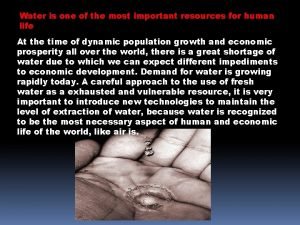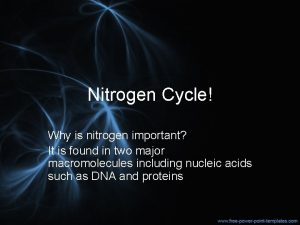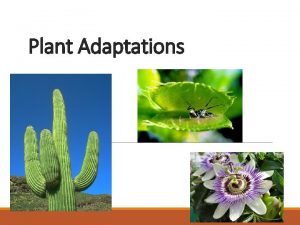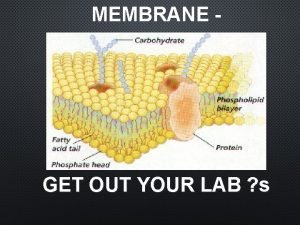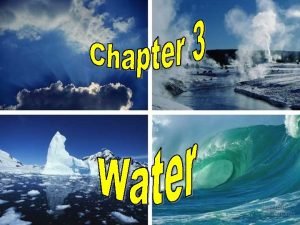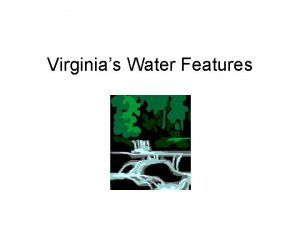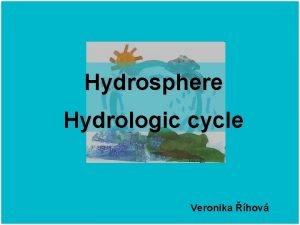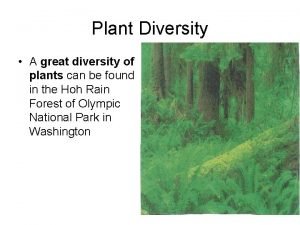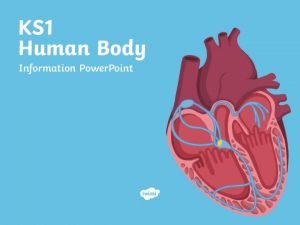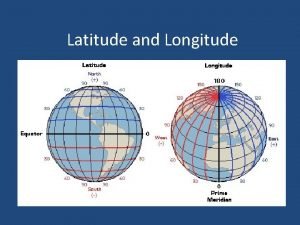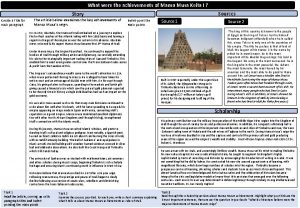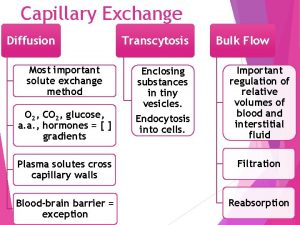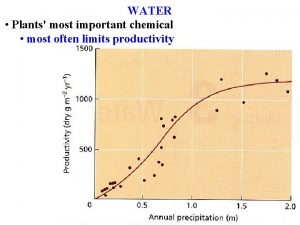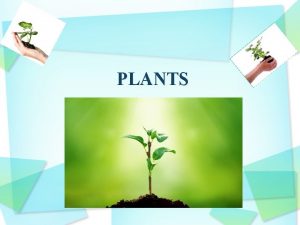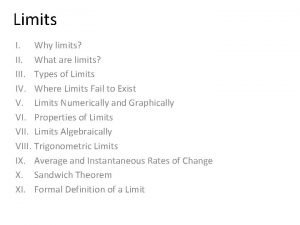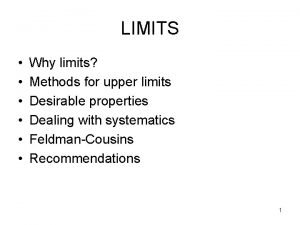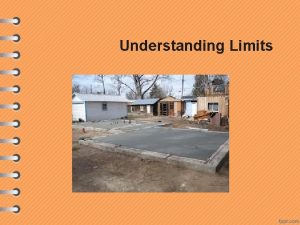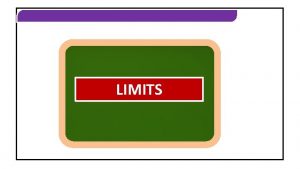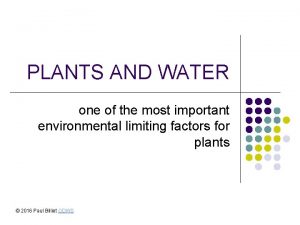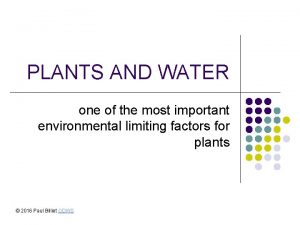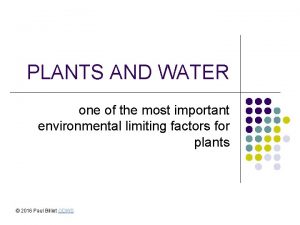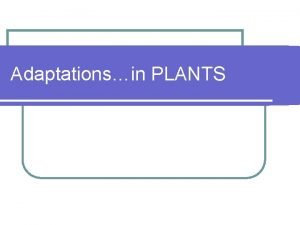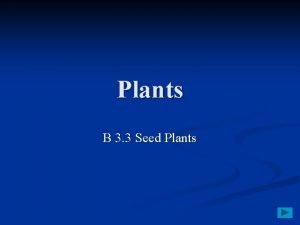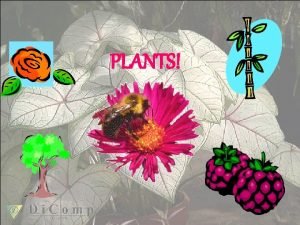WATER Plants most important chemical most often limits






![Water potential Water moves to lower its potential Depends on: 1. [H 2 O]: Water potential Water moves to lower its potential Depends on: 1. [H 2 O]:](https://slidetodoc.com/presentation_image_h2/56803401eda6a0bd8276957ecff9b22f/image-7.jpg)













































- Slides: 52

WATER • Plants' most important chemical • most often limits productivity

Climate change will alter rainfall Overall prediction is that crops will suffer in many parts of world

WATER Constantly lose water due to PS (1000 H 2 O/CO 2 fixed) • Water transport is crucial! • SPAC= Soil Plant Air Continuum • moves from soil->plant->air

Water potential Driving force = water's free energy = water potential Yw • Important for many aspects of plant physiology

Water potential Driving force = water's free energy = water potential Yw Water moves to lower its potential

Water potential Driving force = water's free energy = water potential Yw Water moves to lower its potential
![Water potential Water moves to lower its potential Depends on 1 H 2 O Water potential Water moves to lower its potential Depends on: 1. [H 2 O]:](https://slidetodoc.com/presentation_image_h2/56803401eda6a0bd8276957ecff9b22f/image-7.jpg)
Water potential Water moves to lower its potential Depends on: 1. [H 2 O]: Ys (osmotic potential) 2. Pressure Yp 3. Gravity Yg 4. Yw = Ys +Yp + Yg

Water potential Measuring water potential Ys (osmotic potential) is “easy” • Measure concentration of solution in equilibrium with cells Yg (gravity potential) is easy: height above ground YP (pressure potential) is hard! • Pressure bomb = most common technique Others include pressure transducers, xylem probes

Measuring water potential YP (pressure potential) is hard! • Pressure bomb = most common technique Others include pressure transducers, xylem probes Therefore disagree about H 2 O transport in xylem

Measuring water potential Therefore disagree about H 2 O transport in xylem • Driving force = evaporation in leaves (evapotranspiration) • Continuous H 2 O column from leaf to root draws up replacement H 2 O from soil (SPAC)

Measuring water potential Driving force = evaporation in leaves (evapotranspiration) • Continuous H 2 O column from leaf to root draws up replacement H 2 O • Exact mech controversial

Measuring water potential Driving force = evaporation in leaves (evapotranspiration) • Continuous H 2 O column from leaf to root draws up replacement H 2 O • Exact mech controversial Path starts at root hairs

Measuring water potential Path starts at root hairs • Must take water from soil

Measuring water potential Path starts at root hairs • Must take water from soil • Ease depends on availability & how tightly it is bound

Measuring water potential Path starts at root hairs • Must take water from soil • Ease depends on availability & how tightly it is bound • Binding depends on particle size & chem

Measuring water potential Must take water from soil • Ease depends on availability & how tightly it is bound • Binding depends on particle size & chem • Availability depends on amount in soil pores

Measuring water potential Availability depends on amount in soil pores • Saturation: completely full

Measuring water potential Availability depends on amount in soil pores • Saturation: completely full • Field capacity: amount left after gravity has drained excess

Measuring water potential Availability depends on amount in soil pores • Saturation: completely full • Field capacity: amount left after gravity has drained excess • Permanent wilting point: amount where soil water potential is too negative for plants to take it up

Water movement in plants Water enters via root hairs mainly through apoplast until hits Casparian strip : hydrophobic barrier in cell walls of endodermis

Water movement in plants Water enters via root hairs mainly through apoplast until hits Casparian strip : hydrophobic barrier in cell walls of endodermis Must enter endodermal cell

Water Transport Water enters via root hairs mainly through apoplast until hits Casparian strip : hydrophobic barrier in cell walls of endodermis Must enter endodermal cell Why flooded plants wilt!

Water Transport Water enters via root hairs mainly through apoplast until hits Casparian strip : hydrophobic barrier in cell walls of endodermis Must enter endodermal cell Why flooded plants wilt! Controls solutes

Water Transport Must enter endodermal cell Controls solutes Passes water & nutrients to xylem

Water Transport Passes water & nutrients to xylem Ys of xylem makes root pressure

Water Transport Passes water & nutrients to xylem Ys of xylem makes root pressure Causes guttation: pumping water into shoot

Water Transport Passes water & nutrients to xylem Ys of xylem makes root pressure Causes guttation: pumping water into shoot Most water enters near root tips

Water Transport Most water enters near root tips Xylem is dead! Pipes for moving water from root to shoot

Water Transport Most water enters near root tips Xylem is dead! Pipes for moving water from root to shoot Most movement is bulk flow

Water Transport Xylem is dead! Pipes for moving water from root to shoot Most movement is bulk flow • adhesion to cell wall helps

Water Transport Xylem is dead! Pipes for moving water from root to shoot Most movement is bulk flow • adhesion to cell wall helps • Especially if column is broken by cavitation (forms embolisms)

Water Transport Most movement is bulk flow • adhesion to cell wall helps • Especially if column broken by cavitation In leaf water passes to mesophyll

Water Transport Most movement is bulk flow • adhesion to cell wall helps • Especially if column broken by cavitation In leaf water passes to mesophyll, then to air via stomates

Water Transport In leaf water passes to mesophyll, then to air via stomates Driving force = vapor pressure deficit (VPD) • air dryness

Water Transport In leaf water passes to mesophyll, then to air via stomates Driving force = vapor pressure deficit (VPD) • air dryness • ∆ H 2 O vapor pressure [H 2 O(g)] & saturated H 2 O vapor pressure

Water Transport In leaf water passes to mesophyll, then to air via stomates Driving force = vapor pressure deficit (VPD) • air dryness • ∆ H 2 O vapor pressure [H 2 O(g)] & saturated H 2 O vapor pressure • saturated H 2 O vapor pressure varies with T, so RH depends on T

Water Transport In leaf water passes to mesophyll, then to air via stomates Driving force = vapor pressure deficit (VPD) • air dryness • ∆ H 2 O vapor pressure [H 2 O(g)] & saturated H 2 O vapor pressure • saturated H 2 O vapor pressure varies with T, so RH depends on T • VPD is independent of T: says how fast plants lose H 2 O at any T

Water Transport In leaf water passes to mesophyll, then to air via stomates Driving force = vapor pressure deficit (VPD) • air dryness Rate depends on pathway resistances

Water Transport Rate depends on pathway resistances • stomatal resistance

Water Transport Rate depends on pathway resistances • stomatal resistance • Controlled by opening/closing

Water Transport Rate depends on pathway resistances • stomatal resistance • boundary layer resistance • Influenced by leaf shape & wind

Processes affected by p. CO 2 1)Pathways that use CO 2 as substrate • Calvin cycle (Carbon reduction pathway)

Processes affected by p. CO 2 1)Pathways that use CO 2 as substrate • Calvin cycle (Carbon reduction pathway)

Processes affected by p. CO 2 Calvin cycle (Carbon reduction pathway) 1)Ru. BP binds CO 2 2) rapidly splits into two 3 -Phosphoglycerate • therefore called C 3 photosynthesis

Processes affected by p. CO 2 Calvin cycle (Carbon reduction pathway) 1)Ru. BP binds CO 2 2) rapidly splits into two 3 -Phosphoglycerate 3) catalyzed by Rubisco (ribulose 1, 5 bisphosphate carboxylase/oxygenase) the most important & abundant protein on earth • Lousy Km • Rotten Vmax!

Processes affected by p. CO 2 Calvin cycle (Carbon reduction pathway) Reversing glycolysis converts 3 -Phosphoglycerate to G 3 P consumes 12 ATP & 12 NADPH/glucose

Processes affected by p. CO 2 Calvin cycle (Carbon reduction pathway) Reversing glycolysis G 3 P has 2 possible fates 1) 1 in 6 becomes (CH 2 O)n 2) 5 in 6 regenerate Ru. BP

Processes affected by p. CO 2 5 in 6 G 3 P regenerate Ru. BP Basic problem: converting a 3 C to a 5 C compound feed in five 3 C sugars, recover three 5 C sugars

Regenerating Ru. BP Basic problem: converting a 3 C to a 5 C compound must assemble intermediates that can be broken into 5 C sugars after adding 3 C subunit

Processes affected by p. CO 2 1)Pathways that use CO 2 as substrate • Calvin cycle (Carbon reduction pathway) • Rubisco must be carbamylated & bind Mg 2+ to be active!

Processes affected by p. CO 2 1)Pathways that use CO 2 as substrate • Calvin cycle (Carbon reduction pathway) • Rubisco must be carbamylated & bind Mg 2+ to be active! • Ru. BP binds & inactivates uncarbamylated rubisco

Processes affected by p. CO 2 1)Pathways that use CO 2 as substrate • Calvin cycle (Carbon reduction pathway) • Rubisco must be carbamylated & bind Mg 2+ to be active! • Ru. BP binds & inactivates uncarbamylated rubisco • Rubisco activase removes this Ru. BP (also CA 1 P)
 Water and water and water water
Water and water and water water Horizontal
Horizontal Shape 65
Shape 65 Example of a news story
Example of a news story Inverted pyramid in news writing
Inverted pyramid in news writing Least important to most important
Least important to most important Water is one of the most important resources
Water is one of the most important resources Always often usually sometimes never
Always often usually sometimes never Nonvascular plant
Nonvascular plant Vascular vs nonvascular plants
Vascular vs nonvascular plants Examples of non flowering plants
Examples of non flowering plants C3 plant
C3 plant Why is nitrogen important for plants and animals
Why is nitrogen important for plants and animals Why are seedless vascular plants important
Why are seedless vascular plants important Veins are often formed from hot water solutions
Veins are often formed from hot water solutions Water movement in xylem
Water movement in xylem If you don't water plants they die
If you don't water plants they die Clareville water treatment plant
Clareville water treatment plant How to find pressure potential
How to find pressure potential Grassland adaptations for plants
Grassland adaptations for plants What cells need isotonic solutions to be at homeostasis
What cells need isotonic solutions to be at homeostasis Breakfast cookery definition
Breakfast cookery definition The process of eliminating bones or impurities
The process of eliminating bones or impurities What is a crab dolly? when is it most often used?
What is a crab dolly? when is it most often used? Why is water important to living things
Why is water important to living things Importance of water management
Importance of water management Water features in virginia
Water features in virginia Conclusion of water cycle
Conclusion of water cycle Section 2 classifying chemical reactions worksheet answers
Section 2 classifying chemical reactions worksheet answers Chapter 7 review chemical formulas and chemical compounds
Chapter 7 review chemical formulas and chemical compounds Section 2 classifying chemical reactions worksheet answers
Section 2 classifying chemical reactions worksheet answers Chemical reactions section 1 chemical changes
Chemical reactions section 1 chemical changes Love formula in chemistry
Love formula in chemistry Chapter 18 chemical reactions balancing chemical equations
Chapter 18 chemical reactions balancing chemical equations The most ancient surviving seed plants are the
The most ancient surviving seed plants are the 2 most important commandments
2 most important commandments Salamanca statement
Salamanca statement Most important agent of socialization
Most important agent of socialization What is resocialization
What is resocialization Most important part of the body
Most important part of the body What is the invisible line that runs from north to south
What is the invisible line that runs from north to south 2 most important commandments
2 most important commandments The most important things in life essay
The most important things in life essay Objectives of shampoo
Objectives of shampoo What were mansa musa's most important achievements
What were mansa musa's most important achievements Arrow clip art
Arrow clip art The most important component
The most important component Most important organelle
Most important organelle What is the most important method of capillary exchange
What is the most important method of capillary exchange Existential universal statement examples in math
Existential universal statement examples in math Element of a plot
Element of a plot What is the most important physical property of alcohol?
What is the most important physical property of alcohol? A customer is the most important visitor
A customer is the most important visitor






